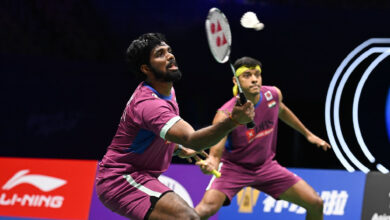Jasprit Bumrah’s mental toughness makes him a crisis man for Virat Kohli

Flashback to 23 March 2016: It’s a virtual do-or-die match for India as they face Bangladesh in the World T20 at M Chinnaswamy Stadium, Bangalore. Bangladesh are chasing a mediocre 147. Opener Tamim Iqbal flicks the first ball of the innings from Ashish Nehra to fine leg. Jasprit Bumrah moves gingerly and lets it through his fingers and into the fence. Not the start you would want.
Four overs later, Tamim top edges a slog sweep off Ashwin. Bumrah, with all the time in the world to gobble it up, spills a dolly. He doesn’t react, he just stares, looking totally blank. Then he comes on to bowl the next over and his confidence takes another beating as the man he had dropped hammers him for four fours in the over. “It’s just not going to be my day,” Bumrah would surely have thought, you feel. But in reality, it is not the case. Bumrah only looks at the good times, filtering out the bad ones. What has happened has happened, it’s a thing of the past – that’s what he believes in.
Jasprit Bumrah exults after India beat England in the 2nd T20I in Nagpur. ReutersJasprit Bumrah exults after India beat England in the 2nd T20I in Nagpur. Reuters
Dhoni brings him back in the 17th over with 34 runs needed off 24 balls, Bumrah’s figures reading 2-0-19-0. He gives away just seven runs. The choke is applied, and pressure is built. He comes back for his last over with 17 runs needed off 12 balls and concedes just six. Mahendra Singh Dhoni’s ‘Usain Bolt’ sprint to run out Mustafizur Rahman, off the last ball, wins the match for India. Bumrah doesn’t concede a single boundary in his last two overs and that, in all probability, is the turning point, which, however, flies under the radar.
Two mistakes at the start in a high voltage clash might not just have dented but battered a 22-year-old’s confidence. But that comeback from Bumrah was a manifestation of his tremendous mental strength.
Ten months later, that mental strength was again on display as he helped India pull off a heist by defending eight runs off the last over in Nagpur against England in the must-win second T20I.
“I don’t focus on the things that happened in the last match. I know my first over was not well and there were some good shots too, the pitch was also a little bit helpful. But I don’t think about that. What has happened is in the past, what next you have to do, I focus on that. I always train like that,” Bumrah toldBCCI.tv after the Nagpur T20I win.
Every now and then, the cliche – bats are getting bigger, grounds are getting smaller, pitches are getting flatter and batsmen are getting more creative – have been thrown around. T20s can be cruel for a bowler and most of the times, bowling at the death can just rip one’s confidence apart. Just ask Ben Stokes who crouched down in disbelief on the Eden Gardens pitch feeling that “the whole world had come down on him” on that sultry evening when Carlos Brathwaite clobbered four sixes in four balls in front of a 50,000-strong crowd to clinch the World T20 title.
Yes, there is a clear disparity between bat and ball. However, the bowlers have no option but to evolve and adapt. And that’s what Bumrah has done over the last one year since Dhoni singled him out as ‘find of the tournament’ on the Australia tour. His understanding of the game has gone a notch higher and as his career has progressed, he has used his unorthodox action to good effect and added variations to his armoury. The continuous learning process has helped but more importantly, he has never lost that self-belief.
“He has an enormous amount of self-confidence because of the fact that he can execute the yorker, a pretty good bouncer, and the slower ball,” India’s bowling coach Bharat Arun toldCricinfo five months ago.
In the Nagpur T20I on Sunday, batting wasn’t easy. The track was slow and the ball wasn’t coming onto the bat. The England bowlers showed that it wasn’t pace or spin but pure intelligence that can apply a stranglehold. Bumrah had come into the T20Is on the back of a disappointing ODI series. He went wicketless in the first T20I with figures of 3.1-0-26-0. The overstepping no-ball wickets (of Jonny Bairstow in the third ODI in Kolkata and Joe Root in the first T20I in Kanpur) didn’t help. The first two overs at Nagpur’s Vidarbha Cricket Association (VCA) stadium were ordinary by his standards. This was the time to display his ability to bounce back. And it’s his ever-evolving mind that came to the rescue. He had read the pitch well.
“I try to assess the pitch and conditions and study the opposition, and try to study what is working for their bowlers. I try to learn from whatever I see. I thought it’s a big ground, so back of length and slower deliveries will be very effective. So I had that in mind,” Bumrah said after the match.
With 27 runs needed off 18 balls, he bowled an excellent over, giving away just three with a set Root and dangerous Jos Buttler at the crease. The two batsmen found it really difficult to adapt to Bumrah’s variations and couldn’t connect or middle their slogs. Nehra then conceded 16 in the penultimate over which brought back pressure on Bumrah. With eight needed off six balls, nine out of ten times, you would back the batting team to get home.
But amidst surging blood pressure, Bumrah’s astute brain worked faster than an Inte; processor as he bamboozled Buttler with his variation, dismantling the stumps with a fast back of a length delivery.
With seven runs needed off two balls, it still wasn’t over. Another couple of slower deliveries followed, which cost just a bye. The Gujarat pacer might have got lucky with Root’s wicket off the first ball (adjudged LBW in spite of an inside edge) of the final over, but the entire last over was a manifestation of sublime death bowling. Yorkers were replaced by slower back of a length deliveries, as planned. Again, not a single boundary was conceded by Bumrah in his last two overs and just a single and a bye in his last over. Implementing a stellar over with significant dew around made Bumrah’s performance all the more special. And it was his mental strength that stood out.
“Bumrah’s strength is bowling with the old ball – whether it’s the slower ball or yorker. I have been playing T20s with him for the last one year and he backs himself mentally in the death (overs),” Nehra said in the post-match press conference.
In tense situations with suggestions flowing in from every corner, there is a high possibility of the mind getting cluttered. Captain Virat Kohli giving a free hand to the youngster helped, but it was Bumrah’s clarity of mind that mattered the most.
“I was trying to have a clear plan, stick to the basic plan that I have (and) trying to back my strengths, because if you have double thoughts then it won’t work. So I will decide what ball to bowl and I will stick to that. If he hits then it’s my responsibility. So I was very happy that I was able to stick to my plans and back my strengths,” Bumrah told BCCI.tv after the match.
“After we came so close after eight runs were needed (off the last over) till six runs were needed off the last ball (sic) so we were just thinking what were the options that I had. A lot of suggestions came up and in the end I decided what I had to do,” he added.
In all, Bumrah bowled seven slower balls, six of them were at the death. While Nehra’s role was crucial, it was Bumrah’s death overs that kept India alive in the series. He conceded just seven runs off his last 15 balls, scalping two wickets. Over the last two years, he has been one of the most economical death bowlers in T20Is which is a testament to his hunger to evolve and mental resolve. Bumrah’s Nagpur heroics proved that not only has he grown beard on that baby face, but gained in maturity as well.







